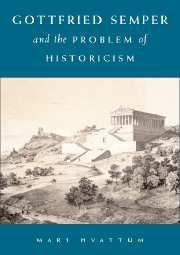Book contents
- Frontmatter
- Contents
- List of Figures
- Prolegomenon
- Introduction – Gottfried Semper: Texts and Interpretations
- PART I TOWARDS A POETICS OF ARCHITECTURE
- PART II PRACTICAL AESTHETICS
- PART III THE APORIAS OF HISTORICISM
- 7 Semper and the “Style of Our Time”
- 8 History and Historicism
- 9 Between Poetics and Practical Aesthetics
- Epilogue
- Notes
- Selected Semper Bibliography
- Bibliography
- Index
7 - Semper and the “Style of Our Time”
from PART III - THE APORIAS OF HISTORICISM
Published online by Cambridge University Press: 06 August 2009
- Frontmatter
- Contents
- List of Figures
- Prolegomenon
- Introduction – Gottfried Semper: Texts and Interpretations
- PART I TOWARDS A POETICS OF ARCHITECTURE
- PART II PRACTICAL AESTHETICS
- PART III THE APORIAS OF HISTORICISM
- 7 Semper and the “Style of Our Time”
- 8 History and Historicism
- 9 Between Poetics and Practical Aesthetics
- Epilogue
- Notes
- Selected Semper Bibliography
- Bibliography
- Index
Summary
“The great question is, are we to have an architecture of our period, a distinct, individual, palpable style of the nineteenth century?”
T. L. DonaldsonIf in Part II I mapped the theoretical framework that underlies Semper's practical aesthetics, it is now time to address how Semper believed this framework could affect contemporary architectural practise. Having looked at Semper's theory of practise, in other words, we must now examine his practise of theory. Although Semper warned against attempting to implement the formula for style directly, he nevertheless insisted on its applicability. The practical aesthetics was meant to be not just another contribution to aesthetic speculation, but also “sufficiently specific and complete in itself to be of practical use”. My concern in Chapter 7 is to identify this ‘practical use’ and to look for the way in which Semper's practical aesthetics delineated the role and responsibility of architecture in the nineteenth century.
More than anything, the architectural discourse of the first half of the nineteenth century was conditioned by the problem of self-expression: how to conceive and craft a ‘style of our time’. At the time Semper formulated his theory of style, the question “In which style should we build?” had already fuelled debate for decades. The debate rested on two related assumptions. First, it relied on a notion of style understood as the relative character of time and place.
- Type
- Chapter
- Information
- Gottfried Semper and the Problem of Historicism , pp. 149 - 161Publisher: Cambridge University PressPrint publication year: 2004
- 1
- Cited by



